Introduction: Olmsted’s Philosophy and Principles of Landscape Design
Before starting the virtual tour of Thanks-Giving Square and the evaluation of its architectural design, it is necessary to give the outline of design principles formulated by outstanding landscape architect Frederick Law Olmsted Sr. Initially, he was not a professional landscape designer per se and did not receive the formal education in this sphere (“Olmsted, Frederick Law.”). Therefore, his approach was based on an intuitive understanding of harmony in the landscape. He was certain that a landscape designer should keep nature in its pristine state, allowing only minor changes (Ferguson). According to Olmsted, all the transitions between the park zones should be subtle, and visitors should not consciously perceive them (“Olmsted, Frederick Law.”). That is why his approach was called “site design of the unseen.”
Structure and Functions
Thanks-Giving Square is an architectural complex that includes multifaceted components and performs several functions. It was designed by a Pritzker-winning architect Philip Johnson (“Exhibition: “Thanks-Giving Square”; “Philip Johnson”). Despite not having much space, he managed to fit several elements of different nature on this small green island among grey roads and city buildings. Thus, its natural elements create a pacifying and recreational effect, while cultural and religious sites play educational and spiritual roles.
Unity with Nature
Thanks-Giving Square offers visitors a rest from busy city life. Located within noisy Dallas streets and combining natural and culturally significant elements, it embodies a little green haven that can provide spiritual revitalization. It aligns with Olmsted’s idea that parks should provide visitors ways to “escape from the intensity of the city” (“Olmsted, Frederick Law.”). The Garden and the Great Fountain allow Dallas inhabitants and guests to enjoy the calming effect of vegetation and flowing water which might be difficult to find in the modern urban landscape.
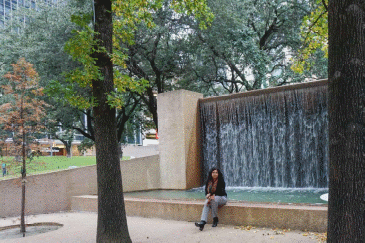
Site Design of the (Un)seen
Johnson managed to present some of the natural elements of his design in a subtle manner. For instance, the fountain has a simple form, almost unnoticeable at first. It also follows Olmsted’s vision of the unseen and can be an example of smart improvisation. Instead of building a fountain of a traditional shape that would steal the attention of the Chapel and other primary elements, he made it almost invisible in their background. At the same time, visitors unconsciously feel its presence by hearing the flowing water.
However, Johnson’s design does not fully follow Olmsted’s philosophical views on landscape design. While Olmsted saw the “concept of pristine wilderness and nature back into the cities” as the core of harmonious park or garden design, Johnson preferred natural elements to be subdued (Ferguson 284). Thus, instead of blending the lines between different components, he emphasizes them, and the lawns in the garden are rigidly outlined and separated from the brick paths. If Olmsted tried to make all the lines unseen and transitions – unconscious, Johnson seems to have a more straightforward approach. Therefore, the structure of his sites cannot be described as temporary or particularly informal.
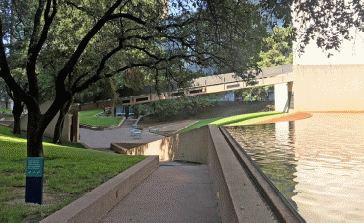
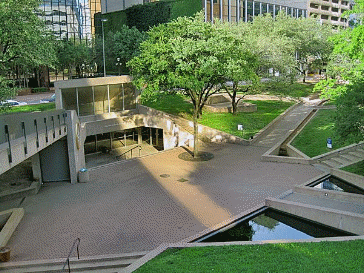
Creative Elements and Improvisation
Nevertheless, Johnson’s design is not overly formal either, as it contains unusual and sometimes unexpected elements of creativity and improvisation. Despite its educational and spiritual roles, the Thanks-Giving Square does not look particularly rigorous. For instance, the Chapel does not resemble a typical religious building that follows rigid architectural rules. Johnson made it in an unusual shape by softening the lines and hiding colorful stained glass windows seen only from above. In this way, the Chapel stands out but does not attract too much attention due to its white color and lack of visible intricate ornaments. It makes it a harmonious part of the design complex.
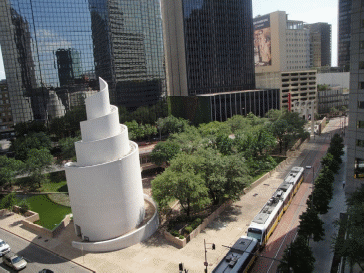
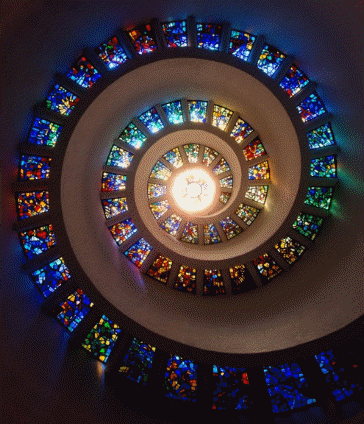
Conclusion
In conclusion, Johnson managed to use the allocated space wisely and create a harmonious landscape complex for recreational, educational, and spiritual purposes. The presence of the natural element and the ability to improvise to unify various components into one site likens his design approach to Olmsted’s. However, it seems less subtle, as Johnson does not hesitate to highlight some elements with rigid lines and straightforwardly direct the visitors across the Thanks-Giving Square. Thus, Johnson’s structures cannot always be described as temporary or informal.
References
“Exhibition: “Thanks-Giving Square: An Idea Becomes a Place.”” Thanks-Giving Foundation. Web.
Ferguson, Benjamin. “Frederick Law Olmsted: a pragmatic exception to Transcendental writing.” Studies in Travel Writing, vol. 24, no.3, 2020, pp. 283-297. Web.
“Olmsted, Frederick Law.” The Wiley Blackwell Encyclopedia of Urban and Regional Studies. 2019.
“Philip Johnson.” Brittanica. Web.
“Thanks-Giving Square.” Thanks-Giving Foundation. Web.